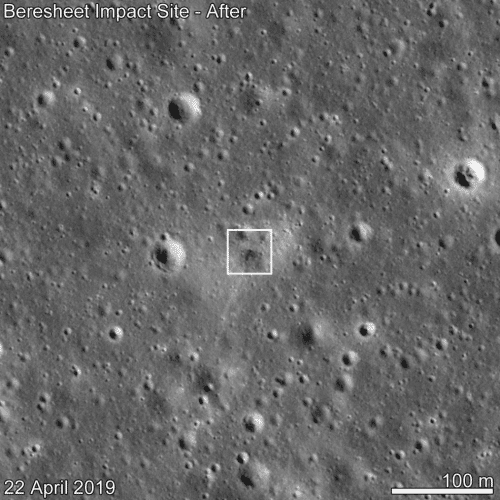LROC photographed the crater from an altitude of 90 kilometers above the ground. The cameras picked up a dark spot about ten meters wide that indicates the point of impact. The dark color indicates that the surface was disturbed due to the crash, and they reflect less light from clean and smooth surfaces

The Genesis crash site was photographed by the LRO spacecraft on April 22, 11 days after the landing attempt. Photo: NASA/GSFC/Arizona State University
The attempt by the SpaceIL association and the aerospace industry to land a spacecraft on an ancient volcanic field on the near side of the moon failed. After a smooth descent, the spacecraft made a hard landing on the surface.
On the first occasion when NASA's Lunar Reconnaissance Orbiter (LRO) passed over the landing site, on April 22, 2019, LRO photographed the Genesis impact crater. The spacecraft has been circling the moon and photographing its surface for a decade with the help of the LRO camera (LROC) consisting of three imaging devices, a wide-angle camera that shoots in seven colors (WAC) and two narrow-angle cameras that shoot in black and white (NAC). It was these cameras that recorded the Genesis impact crater.
LROC photographed the crater from an altitude of 90 kilometers above the ground. The cameras picked up a dark spot about ten meters wide that indicates the point of impact. The dark color indicates that the surface was disturbed due to the crash, and they reflect less light from clean and smooth surfaces.
From this altitude, LRO could not find out whether Bershit created a crater at the time of the impact. The crater may simply be too small to be seen in the pictures. Another possibility is that in the beginning it entered the ground given the low angle of entry (8.4 degrees relative to the surface), its small mass (compared to a compressed meteorite of a similar size), and its low speed again compared to a meteorite of a similar size, although absolute, the speed is 500 km/h greater from most of the rifle bullets.
The bright halo around the spot could have been created from gas that was dispersed during the impact or from dust grains that were blown up during the fall of the Beresheet spacecraft, which smoothed the ground around the landing site and caused it to reflect light better.
There are many clues that we are indeed observing a man-made crater and not due to a meteorite impact. This is an important consideration, since the moon has no atmosphere, and is therefore constantly bombarded by rocks from space that leave craters. We also know where the crash site is within a radius of a few kilometers thanks to tracking the Genesis radio systems. Also, there are 11 photos of the area from before the crash, over an entire decade, and three photos after the crash. In all of these images, including one taken 16 days before the landing, we only saw one new formation on the ground of the size it would have originally formed.
Mathematical models helped NASA estimate the size and shape of the crater that might have been created by a bone impact with the mass and speed of Genesis on the ground. The researchers compared this crater with those created by the impact of similar-sized spacecraft (GRAIL, LADEE, Ranger) that hit the moon at about the same speed and saw that the white tail that stretched from the landing halo towards the south, consistent with the direction of the Genesis landing - south.
As a marker of what the area looked like before the crash, a photograph taken by LRO on December 16, 2016 was shown. This is due to the similar lighting conditions based on the angle at which the sun illuminates the moon at this particular time of the orbit and was the most similar in these conditions to the photo taken on April 22, 2019.
Because LRO was below the horizon when Genesis descended and crashed, it could not photograph the area until its orbit brought it there, 11 days later. LRO passes over the poles of the moon in the whole coffee. In the meantime, the moon rotates around an axis under the spacecraft and thus it allows the LRO to pass over any part of the moon twice a month - once during the lunar night and a second time during the lunar day. LROC may take additional images of the landing site when it passes over the same area again on May 19.
At the same time, NASA will try to send laser pulses from LRO's altimeter to measure the reflection of the laser reflectors of a small cube made of mirrors. This device was supplied to Bereshit by NASA's Goddard Space Flight Center and installed on top of the Bereshit spacecraft. The engineers will try to find out if this reflector survived the impact.

3 תגובות
There will be greater successes than this spacecraft for Israel. Criticism would be wrong.
Dear Anonymous User,
No need to clean!
It will only be a matter of time before some Israeli politician declares that the remains of "Bereshit" are not garbage - but that it is a "monument to the memory of the space pioneers of their generations, who dedicated their lives to opening the gates of human migration from Earth to the expanses of deep space, with the aim of preserving and preserve the human race".
Then the State of Israel will officially declare the site an "Israeli heritage site", and after a few decades even the UN will declare it a "world heritage site"...?
As on the shores of the Sea of Galilee, on the moon too no one thinks to clean up the dirt they left behind.